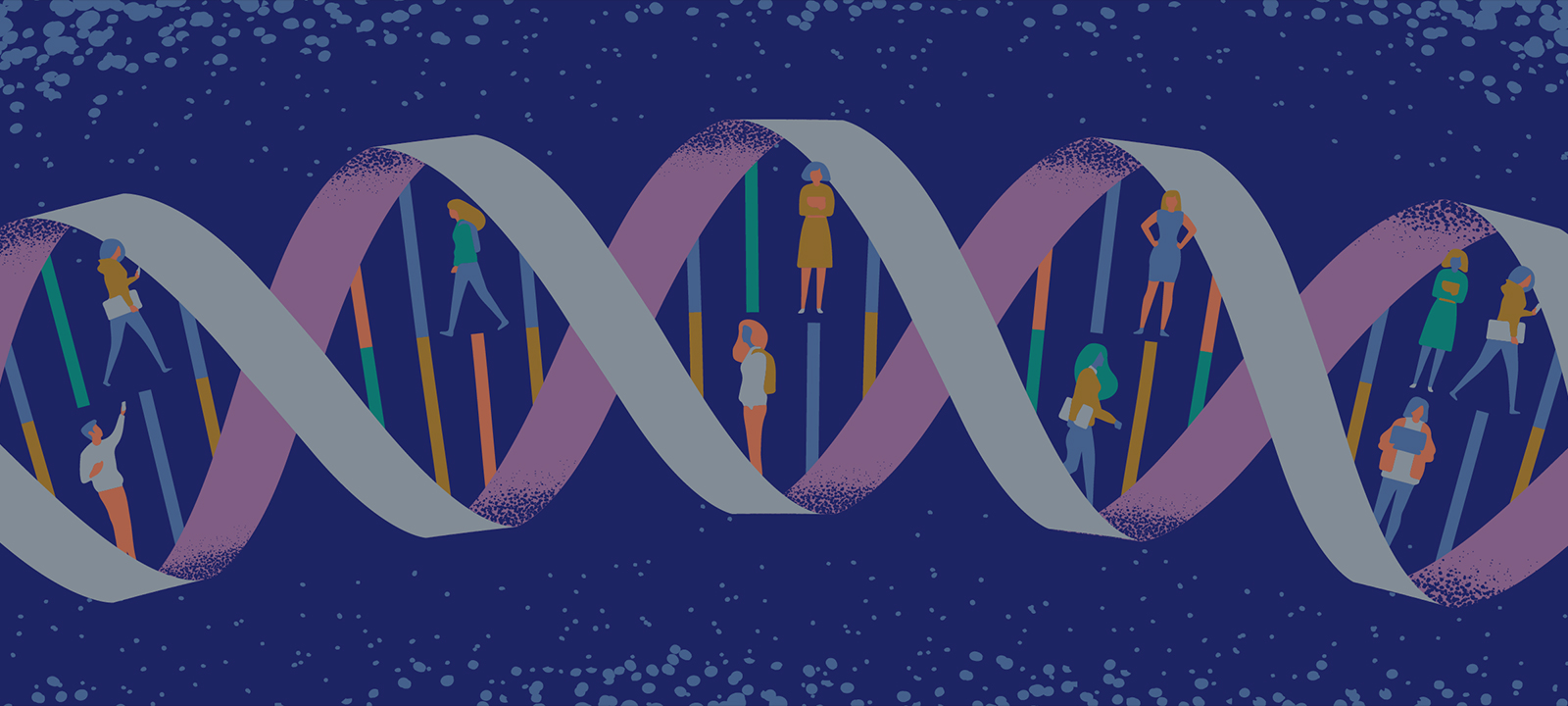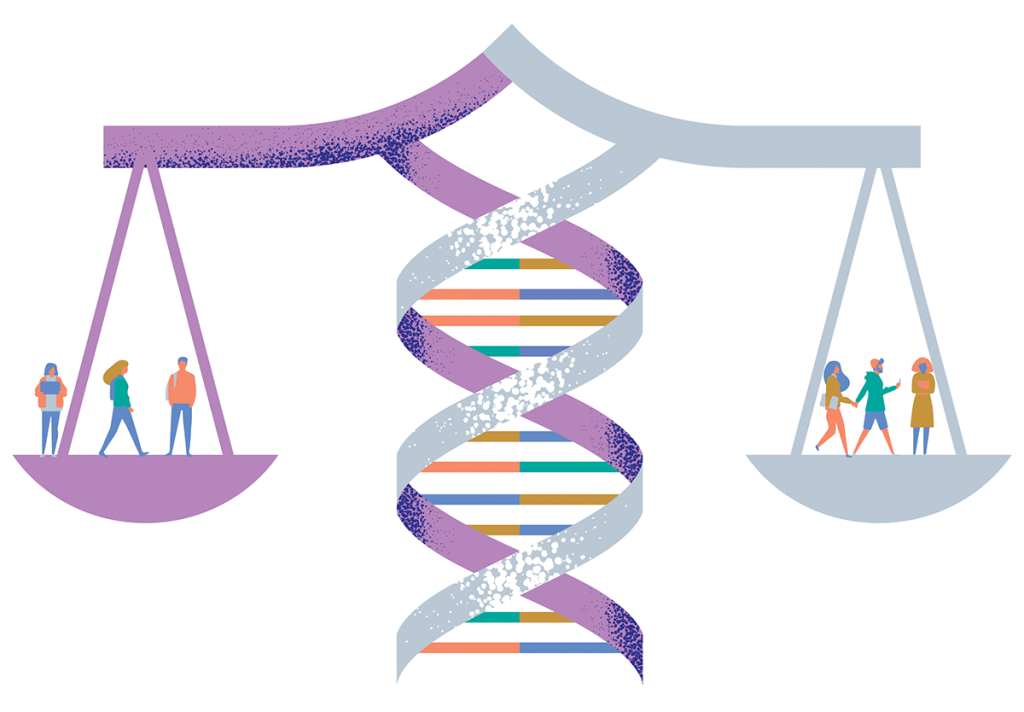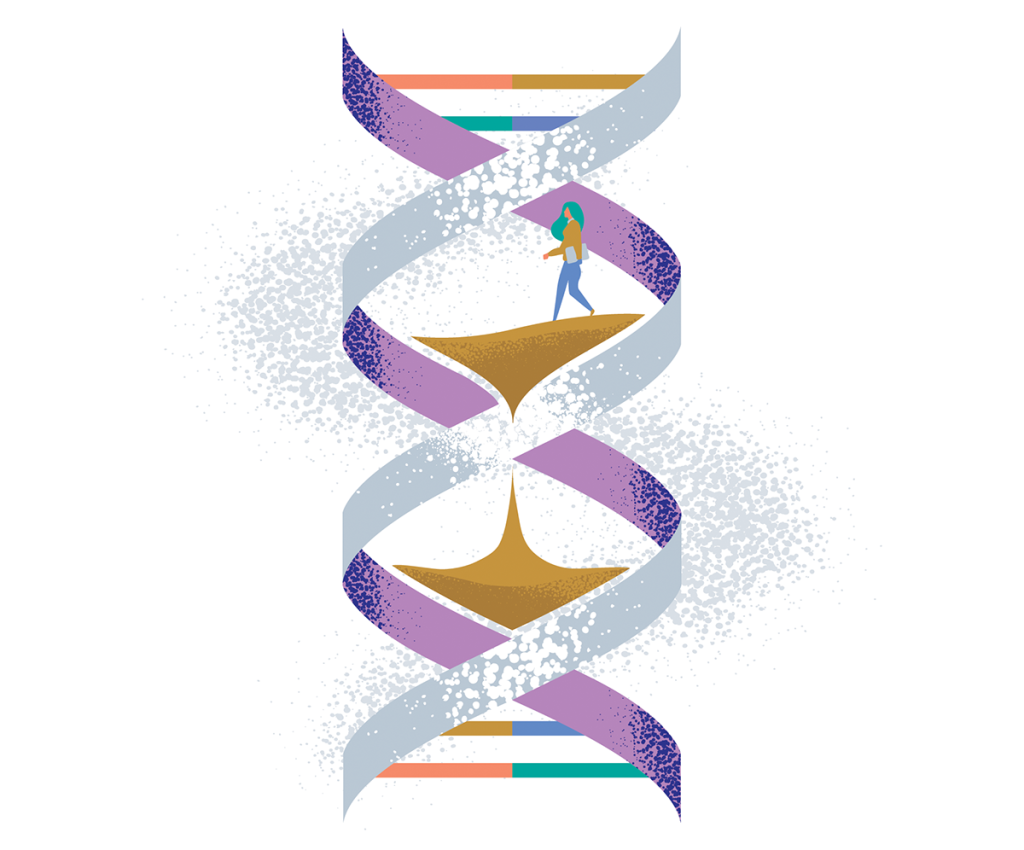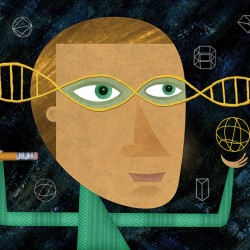
The Truth in Our Genes
UW researchers have new tools for explaining who we are and improving our lives.
How much information about ourselves is too much? As the field of genetics advances, with the relatively new ability to cheaply sequence a person’s entire genetic makeup, it’s a question we should all be ready to confront.
Consider a screening that, with a drop of blood, records a newborn’s complete set of genes — collectively known as the genome — and calculates risk scores for thousands of potential medical and social outcomes. Indicators for autism, dyslexia, diabetes, ADHD, depression, and even low educational attainment become part of the newborn’s permanent medical record.
Though not yet practical, all of that is already possible. And one can easily imagine the benefits of such an approach: earlier diagnoses, faster interventions, better treatments. In the future, pairing information about patients’ social circumstances with their genetic code could help medical providers prescribe a drug that’s more likely to be effective. This innovative approach is called precision medicine, with its most promising applications so far in cancer treatment.
But why stop there? Genomic data could easily have social and policy applications. If a child is shown to have a higher risk score for a learning disorder, schools could provide supports earlier, subsidized by the government, before she falls behind in class.
For all the promise, there is plenty of peril in such a brave new world. The field of genetics has journeyed down dark paths before, from the horrors of eugenics to the debunked science of The Bell Curve. Genetic discrimination could flourish, such as life insurance companies hiking up rates on policyholders with high-risk medical indicators. Schools could factor genetic potential into the admissions process.
UW–Madison has become a leading hub for researchers who are exploring these complex issues, which they pursue with equal parts enthusiasm and caution. They’re trying to better understand how our genes interact with our environments, which is the underpinning of the emerging field of social genomics. The UW is investing heavily in it through the Initiative in Social Genomics — a research group and cluster hiring effort that fosters collaboration across academic disciplines.
“We recognized that we were all using the same large-scale genomic data sets to study complex social outcomes,” says James Li, an associate professor of psychology at UW–Madison. “And it’s really unusual that researchers with an economics background or a biostats background or a public policy background or a psychology background or a population health background could all speak the same language with one another. And the language we were speaking was genetics.”
It’s a language only made possible by the genomic revolution of the past 20 years, one with many implications for our future.
Cracking the Code
The Human Genome Project was something of a moon shot to fully sequence the human genome. The massive scientific endeavor involved thousands of international researchers eager to contribute to the effort that began in 1990. Thirteen years and some $3 billion later, they produced a genetic sequence that accurately captured more than 90 percent of the generic human genome.
Cracking that code opened seemingly infinite possibilities in biomedical research. Scientists no longer had to rely on identical and fraternal twins — the gold standard for genetics research for decades — to explore heritability and how our genes contribute to physical, medical, and social traits. Now they could study everyone.
The genomic revolution was here.
Still, the cost of sequencing even one person’s genome was prohibitive — some $100 million in 2001. As a result, researchers had to strategically select a small segment of their subjects’ DNA to analyze. A frenzy of articles followed, linking variance in individual genes to different medical and social outcomes, such as depression, ADHD, and academic success. Any gene theorized to influence an outcome was called a candidate gene. You may even remember magazine covers hyping the search for a “gay gene” — definitive proof that sexual orientation is hardcoded at birth.
But there was a problem with all these studies: none could be reliably replicated. Researchers soon realized that single-gene explanations for outcomes are the exceptions rather than the norm, limited to rare genetic conditions that follow simple inheritance patterns — like sickle cell and Huntington’s.
“In retrospect, it was silly of scientists to think that they would find the gene, or even the handful of genes, for sexuality or for IQ,” writes Jason Fletcher MS’03, PhD’06, a UW–Madison professor of public affairs, in his 2017 coauthored book The Genome Factor. “Social life is infinitely more complicated than eye color (which is influenced by three genes). Even something as biologically determined as height (which is 80–90 percent heritable) is highly polygenic — that is, influenced by thousands of genes, each with tiny effects. And if height is affected by that many genes, then social behavior must involve almost every gene known to humankind.”
Meanwhile, the cost of sequencing a human genome was dropping at a dizzying rate. By 2016, the cost per human genome had decreased to $1,000, and to a fraction of that for a representative sample.
International consortia were able to compile genomic data sets with hundreds of thousands of DNA samples. There was no longer a need to hypothesize about candidate genes — now every gene could be tested with what’s called a genome-wide association study.
To make up our genome, every cell in the human body holds a copy of 3 billion DNA base pairs. The sequence of these pairs directs our human form and function. And since 99.9 percent of them organize identically across the genome in humans, the 0.1 percent variation between people can hold consequential clues about their differences.
Researchers now have data for more than 2.5 million of these genetic variants. New technology can scan a set of genomes and flag statistically significant associations between the variants and practically any human trait. Only some people, for example, can smell a distinct odor in their urine after eating asparagus. In 2016, Harvard researchers found 871 variants, all located in one region of the genome, that are highly associated with an inability to do so.
Since 2008, researchers have found some 430,000 associations between genes and traits across 6,000-plus studies.
Taking it one step farther, researchers can look at an individual’s genetic variants and calculate his genetic risk for any associated outcome (what’s called a polygenic score).
For UW researchers in the Initiative in Social Genomics, these new tools have proven useful for exploring how our genes interact with our social environments — and how we may be able to use that information to improve health care and public policy.
Genetic Inequalities
Every Thursday, the core faculty members of the UW’s Initiative in Social Genomics, along with graduate students and postdoctoral researchers, convene for a weekly lab meeting. Sometimes they present their latest research findings; other times they banter about the limitations in methodology and the restraint still needed in interpreting results.
They all bring different academic perspectives: Fletcher and Lauren Schmitz in health economics and public affairs; Li in clinical psychology and psychiatry; Qiongshi Lu in biostatistics and medical informatics; Corinne Engelman in population health sciences. Often in collaboration, they’ve published dozens of influential studies that suggest behavior is influenced by varying degrees of environmental and genetic factors. For example, a 2021 study found that while higher educational attainment is usually a good predictor for better cognition in late life, it has less of a positive effect for those with a higher genetic risk for Alzheimer’s.
For some studies, the potential for influencing better policy-making is obvious.
Following a precipitous decline, smoking rates have remained relatively steady in recent decades despite punishing tobacco taxes. In a 2012 article, Fletcher examined the importance of genetics in the response to taxation policy. He found that a genetic variation in the nicotinic acetylcholine receptor affected the influence of tobacco taxation on tobacco use, meaning that those with less of a predisposition to smoking are more likely to be deterred by taxes.
“Should we keep increasing taxes — forcing the remaining smokers to pay a larger and larger share of their incomes in part because they were unlucky in the genetic lottery of life?” Fletcher writes in his book. “Should we subsidize their smoking because they love it so much (due in part to their genetics)? Or should we target these folks for prevention efforts, so they do not start in the first place?”
As is often the case in policy-making, there are no easy answers.
A frustration in genomics research is that, as Fletcher puts it, “humans are in the wild.” Unlike lab animals, you’ll never find two people who have been exposed to the exact same environment at every moment. This makes it difficult for researchers to discern whether our genes are influencing the environments we choose or whether our environments are directly influencing our behavior.
As scientists learn how genes interact with social environments, their findings could transform health care and public policy.
To capture causality more clearly, UW researchers have spearheaded “quasi-natural” study designs. The methodology focuses on just one environmental variation that couldn’t possibly be a consequence of genetic variation. One example is to study Vietnam War draft participants, since their genetics didn’t influence their luck in the lottery. A 2015 paper coauthored by Schmitz explored whether the effect of military service on smoking behavior varied by genetic predisposition. It found that veterans with a higher genetic risk of smoking were more likely to become lifelong smokers as compared to those with similar genetic risk who weren’t conscripted.
Schmitz designed a similar study on the high-school movement in the United States, where enrollment in secondary schools skyrocketed in the first half of the 20th century. It found a significant link between high genetic scores for educational attainment and high-school completion — but only in low-performing states. In high-performing states, there was no difference in completion rates between those with high or low genetic scores.
“I think what we’re seeing is that if the social environment is more equal, and if people are exposed more equally to better conditions, there’s potentially less room for underlying genetic inequalities to take shape,” Schmitz says.
Predicting Your Mortality
UW researchers are starting to dive into an emerging subfield that has swiftly captured the imaginations of social scientists: epigenetics. It turns out our behavior and environment — stress and nutrition, for example — can affect how our genes work.
The most studied epigenomic process is DNA methylation, which plays a role in the cellular process of aging and of cancer development.
Since 2013, researchers have been developing “clocks” that can measure your DNA methylation levels at specific sites and calculate your age. At first, these clocks could, with increasing accuracy, estimate your chronological age. Now they can calculate your biological age as well as your rate of aging — how quickly or slowly your cells are accumulating changes associated with mortality. These advanced clocks are proving to be better mortality predictors than both our chronological age and traditional risk factors (smoking, cholesterol, diabetes, and the like).
UW researchers are taking these measures of biological age to study factors in the social environment that may be associated with accelerated aging.
In a 2022 publication, Schmitz used epigenomic data from the U.S. Health and Retirement Study to research whether in-utero exposure to the Great Depression — and therefore conditions like maternal stress and malnutrition — impacted late-life epigenetic aging. She found that the historic economic downturn had statistically significant negative effects on epigenetic age acceleration in study participants whose DNA methylation was measured in 2016. Remarkably, epigenetic markers from in-utero exposure were still identifiable some eight decades later.
“It should make us take a step back and think, ‘What are the origins of health disparities in our population?’ ” Schmitz says. “Yes, one is our own behaviors — how much we eat, how much we exercise. But what we’re seeing here are disparities at a population level that might start developing before people are even born. That has implications for how we think about spending on health care, reproductive care, and social programs.”
The Biological Question
Major questions still loom over the field of genomics and limit the utility of its findings. The UW’s team, uniquely grounded in both social science and data analysis, has emerged as a national leader in addressing them.
For one, a genetic risk score only captures the statistical probability of an outcome. It doesn’t get us any closer to understanding the underlying biology that causes the outcome.
“We don’t know what the 44 genetic variants that have been identified for major depressive disorder are actually doing [in the body to produce depression],” Li says.
To better understand the biology, Li’s Social and Behavioral Development Lab has teamed up with the Motor and Brain Development Lab at the Waisman Center. The project is integrating genetic testing with brain imaging to study ADHD, autism spectrum disorder, and their concurrence. If the research can link genetic and neural signals, it could lead to earlier diagnoses and better therapeutics.
Another limitation of risk scoring as it’s currently calculated is that it struggles to differentiate between disorders since many of them share the same genetic indicators. This makes it impractical for mental health clinicians to use risk scores as an assessment or treatment tool.
“Our patients don’t come in with one disorder,” Li says. “Mental health isn’t just one thing. It’s really a collection of many different symptoms across many different disorders.”
UW collaborator Qiongshi Lu has become a national leader in developing cutting-edge statistical methods to unravel such complexities and improve the accuracy and clarity of genetic risk scores. And more precision could create a pathway for clinical use.
The Human Condition
For just $200 and a half teaspoon of saliva, a service like 23andMe will sequence your genome in less than a month and send you a profile of your ancestry, personal traits, and medical risk scores. For $500 and a few drops of blood, a company like TruDiagnostic will calculate your biological age.
Ancestry.com will even send you a genetically informed Spotify playlist.
But, as UW researchers warn, the results are only as good as the honest interpretation of them. And the truth is that we don’t know enough yet for them to make much of a difference in your life today. If you find out your biological age is five years older than your actual age, you won’t know why — or how to reverse the trend.
“No one's thought about the protections that we might like to have against being penalized for our genetics.”
And then there are the rising privacy and discrimination concerns, with companies collecting millions of samples from consumers who may not read the fine print.
“People have contributed their DNA without recognizing that it’s really a permanent choice,” Fletcher says. “And no one’s thought about the protections that we might like to have against being penalized for our genetics.”
If your genetic information is breached, you can’t change it like you can a password. In the United States, health insurance companies and employers can’t legally discriminate based on genetics, but Congress nearly weakened those protections in 2017. And it’s still technically legal in the arenas of education, mortgage lending, and life insurance. On dating apps, people are already eager to share personality-test results and partner preferences; what’s to stop us from adding genetics to the mix?
Advances in CRISPR technology and gene editing open yet another Pandora’s box of ethical questions, particularly around the potential to genetically modify embryos. Most countries have enacted a moratorium on human genome editing, though there’s always a risk of a rogue researcher.
Today’s social genomics researchers understand the potential for abuse. In fact, forefathers of the UW’s genetics department — and even a university president — were among those who championed eugenics, marriage restriction, and forced sterilizations in the early part of the 20th century. The university was also home to the first student club dedicated to eugenics and “the physical, mental, and moral improvement of the human race.”
“This is why our social genomics cluster is so important. We have people who understand the social background of the eugenics movement and how it escalated to that,” Schmitz says. “It’s easy to twist scientific findings into saying what you want them to say. We’re always going to have to guard against it.”
At the same time, we can still embrace the potential of genomics in creating a better future — like more personalized medical care for cancer and depression and more equitable social policy.
Amid all the promise and controversy, there’s one thing we can say for certain: the human condition is so complex that we may never fully understand it.
“But,” Schmitz says, “generations hopefully will keep trying.” •
Preston Schmitt '14 is a senior staff writer for On Wisconsin.
Published in the Spring 2023 issue




Comments
No comments posted yet.